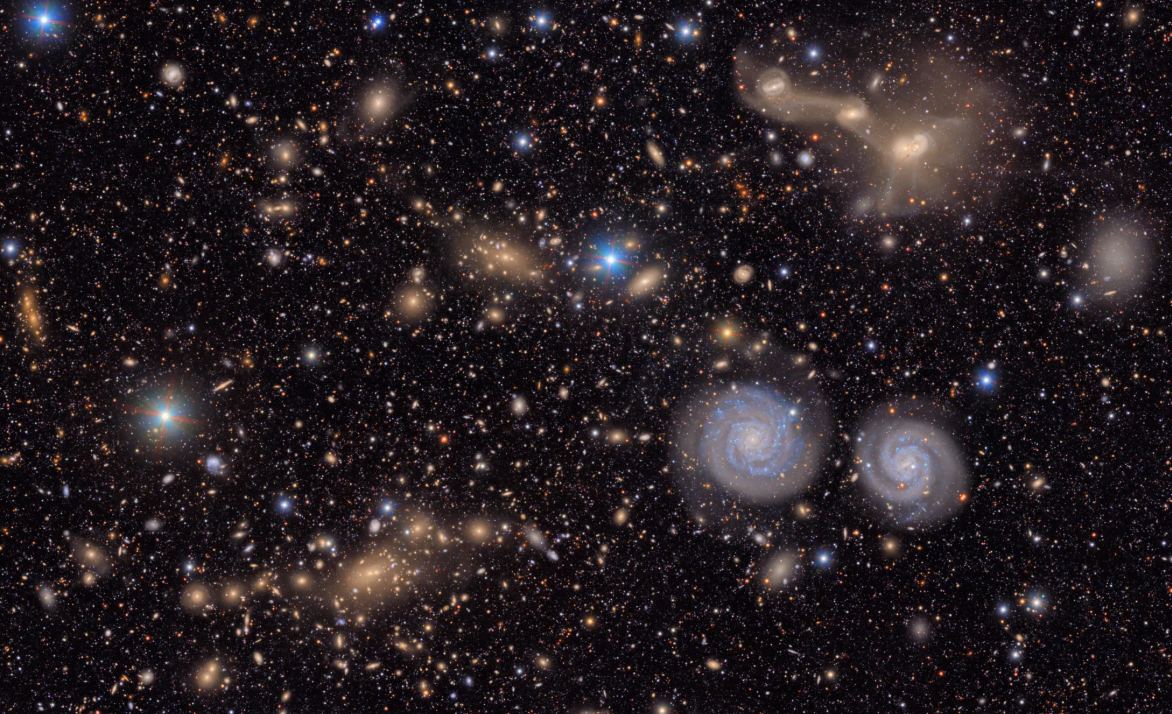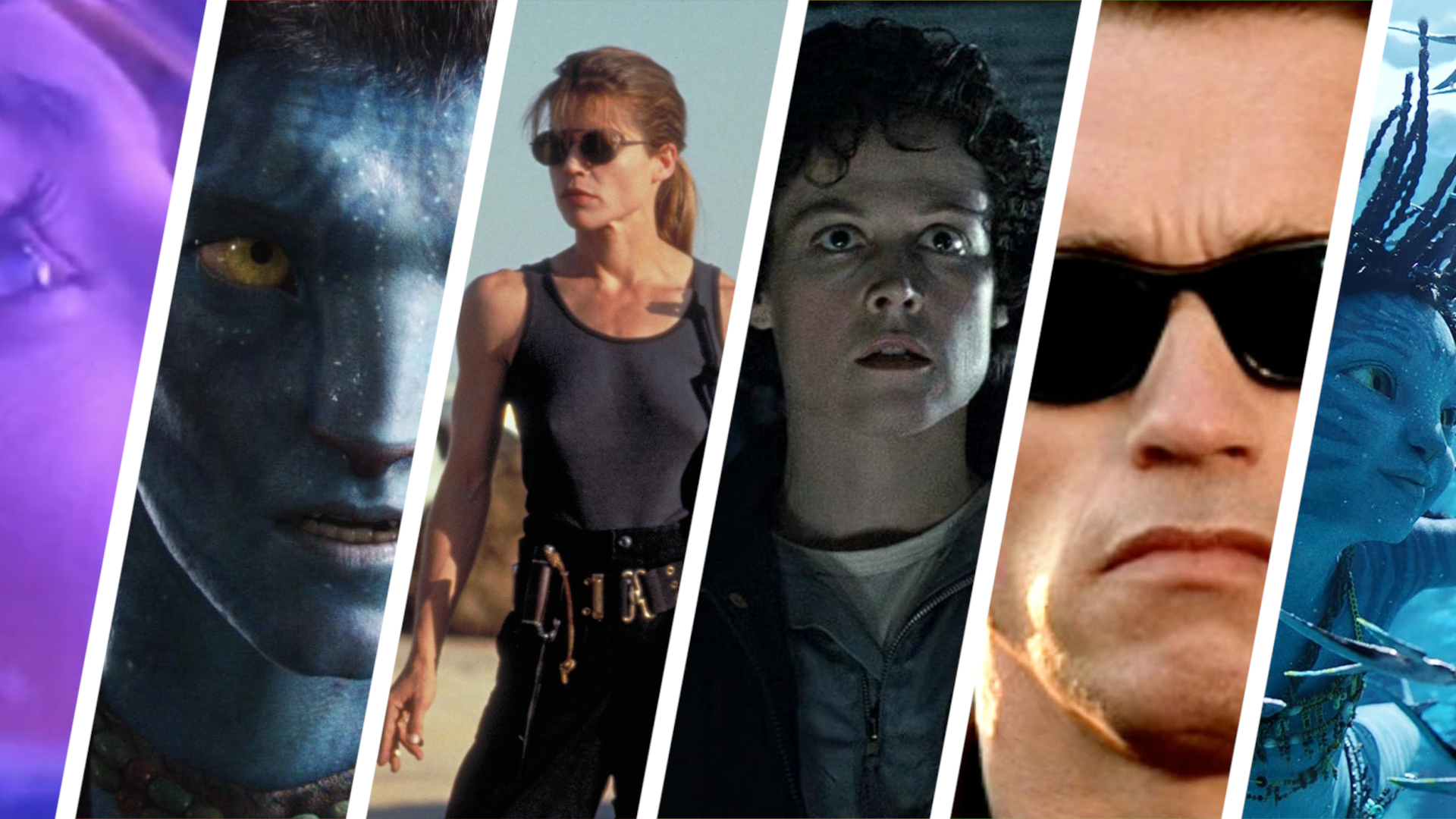Vera C Rubin Observatory reveals 1st stunning images of the cosmos. Scientists are 'beyond excited about what's coming'
"We enter the era of astro-cinematography."

The Vera C. Rubin Observatory has released its first images as it begins its 10-year mission conducting the Legacy Survey of Space and Time (LSST).
The LSST will revolutionize astronomy with one of its primary aims being the investigation of dark energy, the mysterious force driving the accelerating expansion of the universe, and dark matter, the strange substance that accounts for 85% of the "stuff" in the cosmos but remains effectively invisible.
From its perch atop Cerro Pachón in Chile, a mountain that rises around 5,200 feet (1,600 meters) above sea level, Rubin scans the entire night sky over the Southern Hemisphere once every three nights. This endeavor will be the most extensive continuous mapping of the southern sky ever attempted, and will be conducted by Rubin using the 8.4-meter Simonyi Survey Telescope and the LSST camera (LSSTCam), the largest digital camera ever constructed at around the size of a small car.
Just one image from the LSSTCam covers an area equivalent to the size of 45 full moons in the sky. Above is the observatory's first image of the Virgo cluster, a vast cluster of galaxies located around 53.8 million light-years from Earth. The image shows a vast array of celestial objects, including galaxies and stars. Demonstrating the true potential of Rubin, this image alone contains a rich tapestry of about 10 million galaxies.
Staggeringly, the ten million galaxies in the above image are just 0.05% of the number of around 20 billion galaxies that Rubin will have imaged by the end of the LSST. In fact, in a decade, Rubin will have collected data on an estimated 40 billion celestial bodies, meaning we will have seen more heavenly bodies than there are humans alive for the first time.
Unsurprisingly, many of these objects are completely new and viewed by humanity for the first time today. The objects that are familiar have been highlighted in the image below.

"The Vera C. Rubin Observatory will allow us to add depth and dynamism to the observation of the universe," Roberto Ragazzoni, president of the National Institute for Astrophysics (INAF), said in a statement.
"With this 8-meter class telescope capable of continuously mapping the southern sky every three days, we enter the era of 'astro-cinematography', exploring a new dimension: that of time, with which we expect to study the cosmos with a new perspective, which is now possible thanks also to the use of new information technologies to process a mass of data that would otherwise be inscrutable."
If it moves, Rubin will see it
One of the most impressive abilities of Rubin will be its capability to study objects that change in brightness over time as it builds the "greatest movie of all time." This unique power comes from the fact that Rubin can scan the sky at superfast speeds, around 10 to 100 times faster than similar large telescopes.
Breaking space news, the latest updates on rocket launches, skywatching events and more!
The "transients" it sees will include over 100 million variable stars changing their brightness because of pulsations, thermal instabilities, and even because of planets "transiting," or passing between Rubin and their visible disks.
Rubin will also be able to observe millions of massive stars as they end their lives and undergo supernova explosions. The groundbreaking observatory will also investigate so-called "type Ia supernovas," triggered when dead star-white dwarfs undergo runaway nuclear explosions after overfeeding on stellar companions.
Type Ia supernovas are also known as "standard candles" due to the fact that their consistent luminosities allow astronomers to use them to measure cosmic distances. Thus, Rubin will also make an indirect impact on astronomy by providing scientists with a wealth of new and better-understood distances between objects in the universe.
Closer to home, by observing objects as they change in brightness in the night-sky, Rubin will provide astronomers with a better picture of asteroids and small bodies as they orbit Earth. This could help space agencies like NASA assess potential threats to Earth and defend against asteroids.
The YouTube video below shows over 2,100 new asteroids discovered by Rubin in its first week of operations alone.
"If something in the sky moves or changes, Rubin will detect it and distribute the information in real time to the entire world. This means that we will be able to observe transient phenomena in action, making new, often unexpected, astrophysical discoveries possible," said Sara (Rosaria) Bonito of the Board of Directors of the LSST Discovery Alliance of the Vera C. Rubin Observatory.
"Rubin will produce a true multi-colored movie of the sky, lasting an entire decade. A movie that will allow us to see the universe as never before: not just through static images, but in dynamic evolution."
Rubin's power lies in the details
Hours before the release of the main images above at 11 a.m. EDT (1500 GMT) on Monday (June 23), the Rubin team released several smaller "preview" images that are smaller sections of these larger images. These give the general public an opportunity to witness the incredible detail in images captured by the LSST camera.
"These sneak preview images already highlight the uniqueness of Rubin to look at the cosmos in a way that we have never done before, bringing the sky to life!" Andrés Alejandro Plazas Malagón, a researcher at Stanford University and part of the Rubin Observatory's Community Science Team, told Space.com. "These preview images also already highlight the sophistication and power of the software used to reduce or 'clean' the images: the LSST Science Pipelines."
The image below shows the Triffid nebula (also known as Messier 20 or NGC 6514) in the top right, which is located around 9,000 light-years from Earth, and the Lagoon nebula (Messier 8 or NGC 6523), estimated to be 4,000 to 6,000 light-years away. These are regions in which clouds of gas and dust are condensing to birth new stars.
The above picture combines 678 separate images taken by Rubin over just over 7 hours of observing time. By combining images like this, Rubin is capable of revealing details otherwise too faint to see or practically invisible. This reveals the clouds of gas and dust that comprise these nebulae in incredible detail.
"The Trifod-Lagoon image shows these two nebulae or 'stellar nurseries' highlighting regions of gas and dust, made from about 678 individual images," Plazas Malagón said. "It's impressive how the large field of view of LSSTCam captured the scene all at once!"
The image below shows a small section of Rubin's total view of the Virgo cluster. The bright foreground stars in this image are located closer to home, lying in the Milky Way. In the background are many galaxies even more distant than the Virgo cluster.
The image below shows another small slice of Rubin's total view of the Virgo cluster. Visible in the lower right of the image are two prominent spiral galaxies. In the upper right of the image are three galaxies that are colliding and merging.

The image also contains several other groups of distant galaxies, as well as a wealth of stars in our galaxy. It is just one 50th of the entire image it came from.
"The other preview images show a fraction of the Virgo cluster, a galaxy cluster of about 1,000 galaxies. Built from about 10 hours of data, we already see the capability of Rubin to capture the faintest objects with exquisite detail, which will enable amazing science. And these images are just about 2 percent of the field of view of a single LSSTcam image!" Plazas Malagón said.
Following the release of these images, the next big step for Rubin with be the beginning of the LSST, which should occur over the next few months.
"The Vera C. Rubin Observatory and its first LSST project are a unique opportunity for the new generation," Bonito said. "It is a great legacy for anyone who wants to approach scientific disciplines, offering a revolutionary tool for astrophysics and new technologies for data interpretation."
Bonito added that the astrophysics that can be done with Rubin is extremely diversified: a single observation campaign will allow us to respond to very broad scientific themes, which concern our galaxy but also dark matter, our solar system, and even the most unpredictable phenomena that occur in the sky."
And with 10 years of the LSST ahead of it, the future of Rubin and astronomy in general is bright.
"These preview images also already highlight the sophistication and power of the LSST Science Pipelines software used to reduce or 'clean' the images," Plazas Malagón concluded. "As an observational cosmologist and having worked in the development of the LSST Science Pipelines and the characterization of the LSSTCam, I'm proud and beyond excited about what's coming!"
To dive into the first image from Rubin and explore for yourself, visit the Vera C. Rubin Observatory SkyViewer page.

Robert Lea is a science journalist in the U.K. whose articles have been published in Physics World, New Scientist, Astronomy Magazine, All About Space, Newsweek and ZME Science. He also writes about science communication for Elsevier and the European Journal of Physics. Rob holds a bachelor of science degree in physics and astronomy from the U.K.’s Open University. Follow him on Twitter @sciencef1rst.
You must confirm your public display name before commenting
Please logout and then login again, you will then be prompted to enter your display name.


